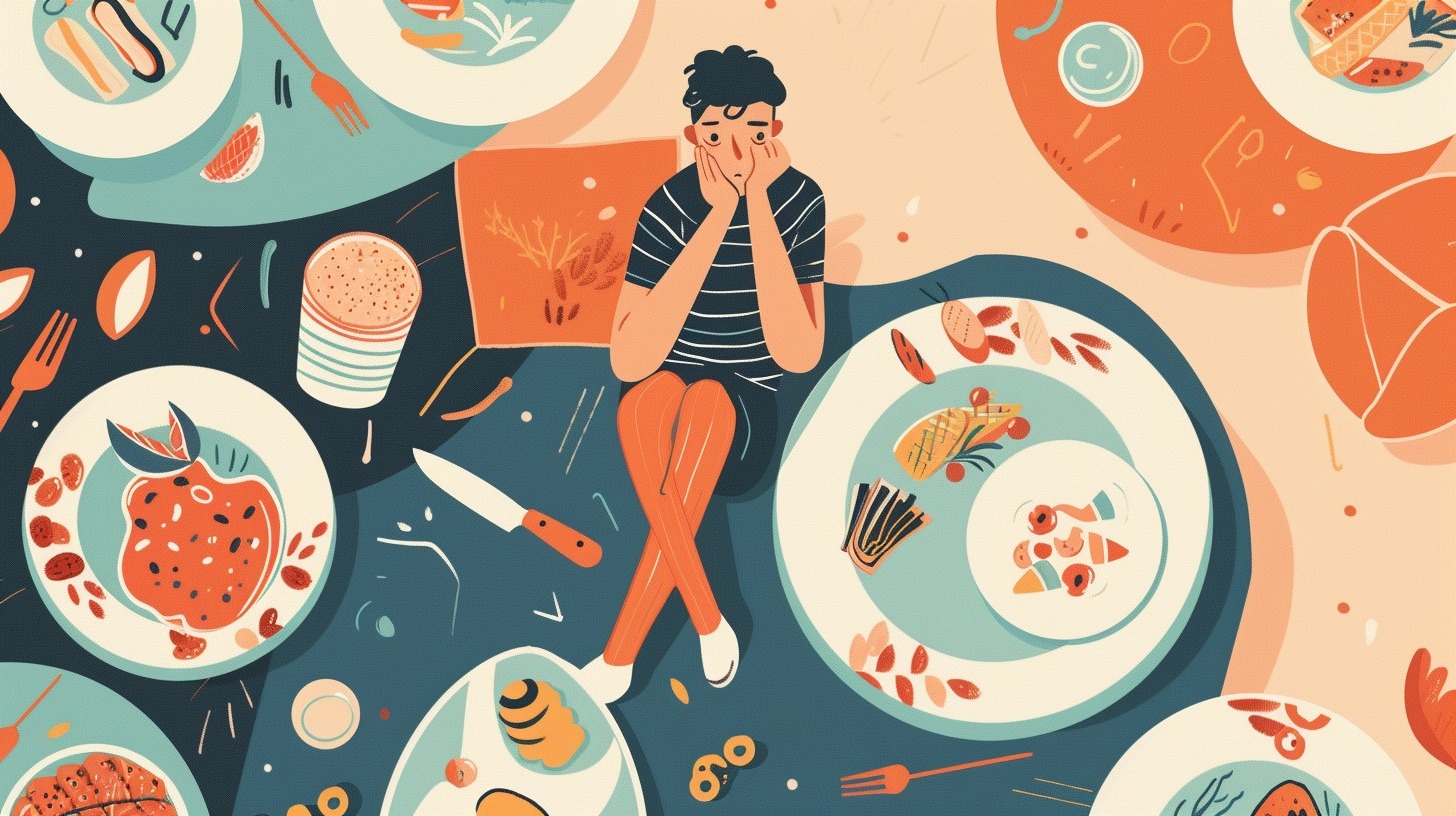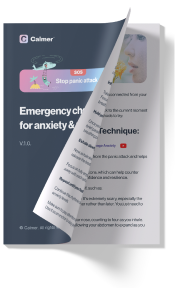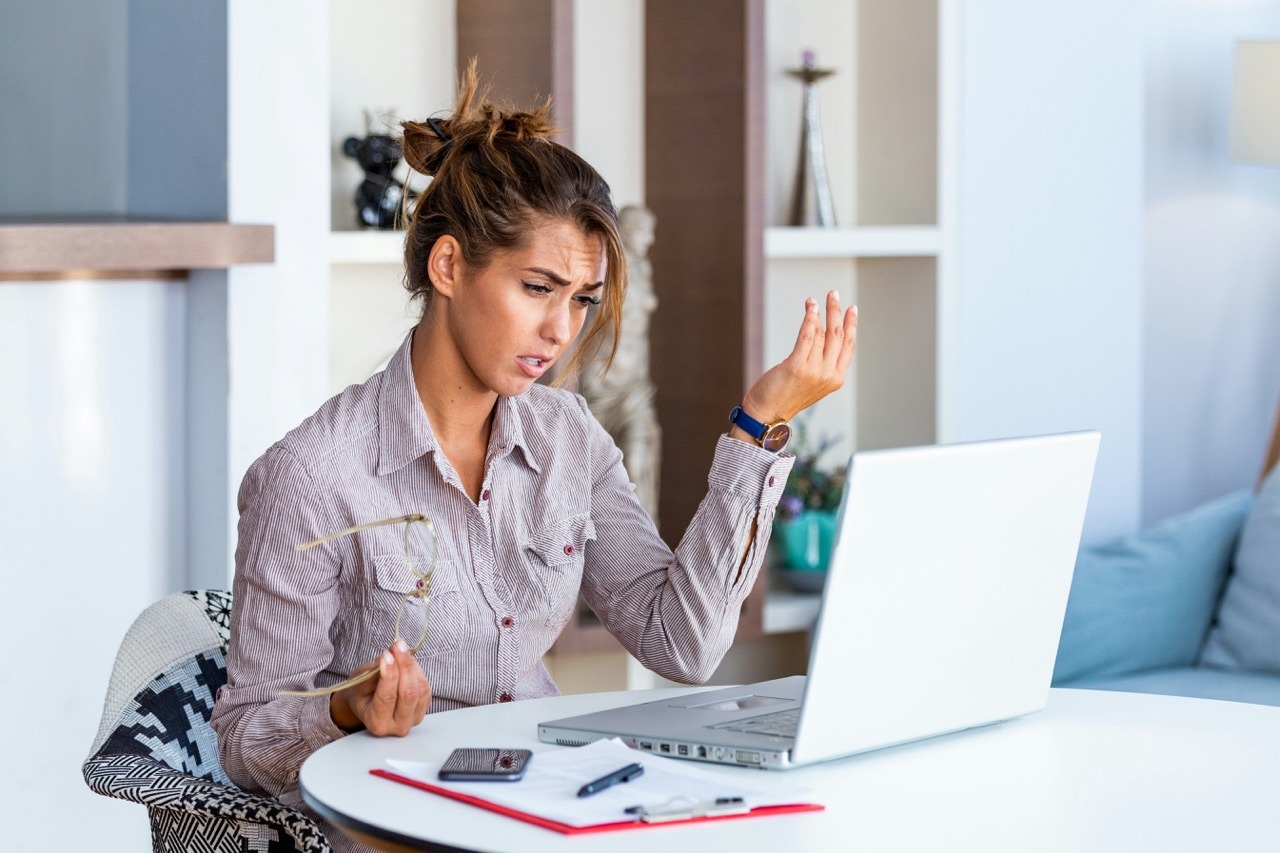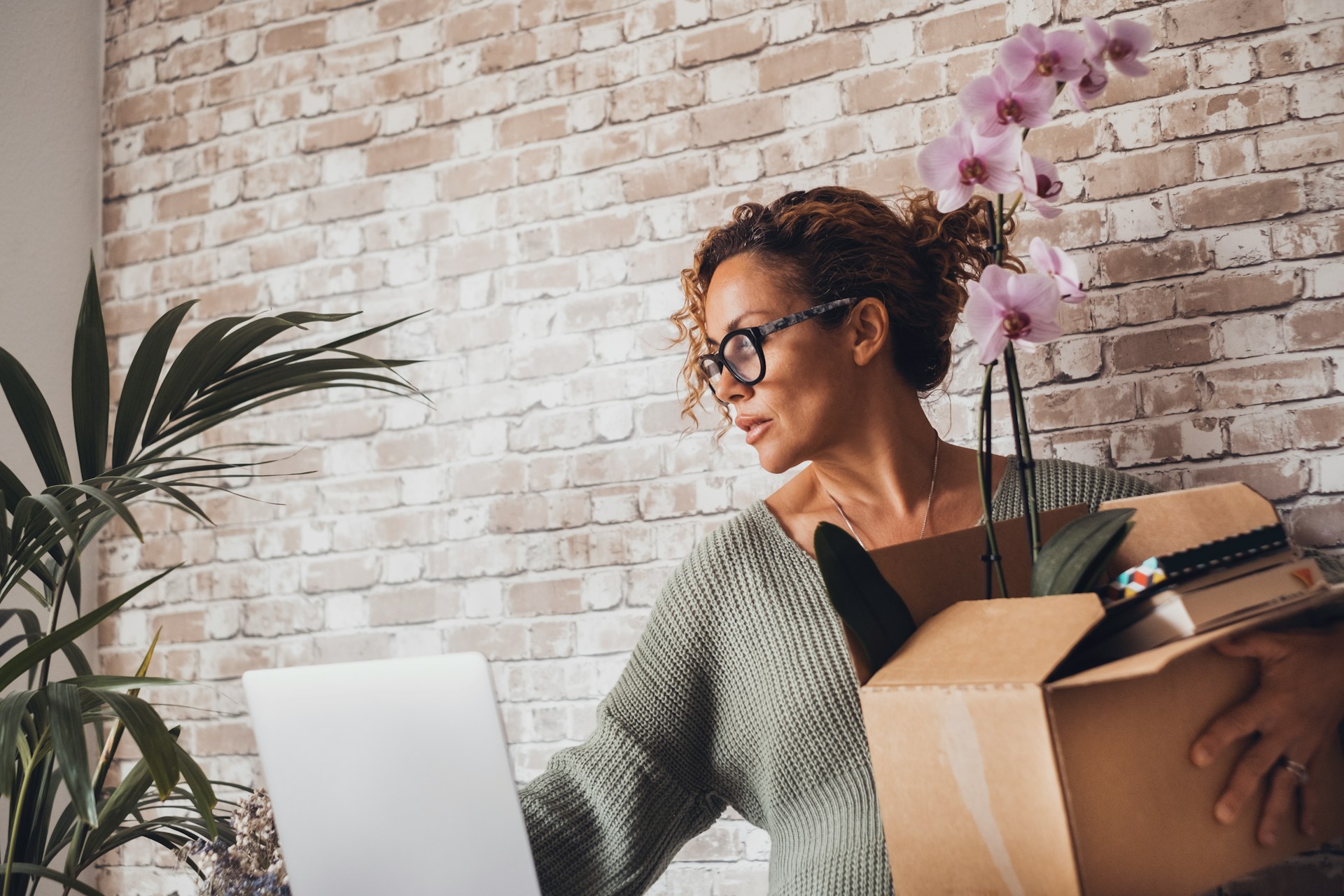I have seen that sometimes people feel anxious after they eat, which makes them uncomfortable and worried. Doctors call this feeling postprandial anxiety, meaning someone gets more anxious after eating food. Different things can cause this reaction, like how the body responds to some foods or mental stress, or sometimes it’s both together. Finding out what causes these problems is not always easy, but it is very important for improving your mental health and feeling better.
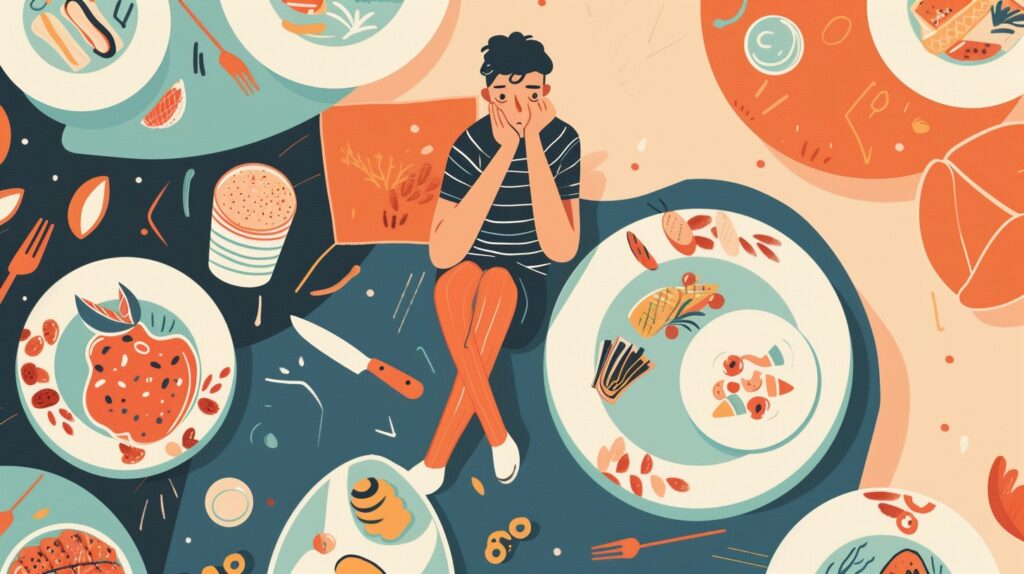
The gut-brain axis, a complex communication network that links the emotional and cognitive centers of the brain with peripheral intestinal functions, significantly influences anxiety’s emergence post-meal within our body’s inner workings. Disruption of this system can manifest as symptoms of anxiety after eating. Furthermore, research has identified specific eating patterns and dietary components that seem to influence this state. This implies that being mindful of our diet could potentially help with anxiety after eating.
Key Takeaways
- Postprandial anxiety is a distressing reaction that occurs after eating.
- The gut-brain axis is pivotal in the development of anxiety symptoms following meals.
- Dietary patterns and meal composition play a role in managing post-meal anxiety.
Understanding Anxiety
I think it’s very important to say that anxiety has many sides. It usually comes with strong feelings of stress and concern, which can affect how we live every day. Understanding where these feelings come from and how they show up is key to dealing with this issue related to our mental well-being.
Causes of Anxiety
I identify stress as a main reason that can cause feelings of anxiety. When someone goes through strong or extended periods of stress, it might result in them always being on high alert, which is the fight-or-flight reaction. This body response includes letting out hormones such as cortisol, which gets the body ready to confront or run away from what it sees as danger. Sadly, if the body keeps releasing cortisol because of ongoing stress, this can lead to continuous anxiety feelings.
Listed below are common catalysts for anxiety:
- Health issues, for example, sickness, can heighten concerns about treatment, prognosis, and the future.
- Financial troubles like monetary strain often bring uncertainty that provokes anxiety.
- Conflicts and disagreements, whether personal or professional, can be significant stressors.
- Work or school demands and the pressure to perform can elicit a profound state of concern.
- Negative experiences like past trauma or abuse can induce a lasting impact, often manifesting as anxiety.
- Personal relationships and challenges in connections with others, such as a breakdown of a significant relationship, can incite anxiety.
Symptoms of Anxiety
I observe symptoms of anxiety on both the emotional and physical spectrums. Emotional symptoms may include persistent worry, irascibility, and mood fluctuations. In the realm of physicality, symptoms such as restlessness, a quickened heart rate, and gastrointestinal distress can arise. In moments of intense anxiety, I might experience what is termed a panic attack, a sudden onslaught of overwhelming apprehension accompanied by symptoms such as palpitations, sweating, and shortness of breath.
Here is a straightforward enumeration of anxiety symptoms.
Emotional:
- Ongoing worry
- Mood changes
- Irritability
Physical:
- Increased heart rate
- Sweating
- Gastrointestinal issues
I refer to the physical manifestation of anxiety symptoms as psychosomatic responses, where emotional distress contributes to physical symptoms. These responses underscore the intertwined nature of mental and physical health and the importance of addressing both to manage anxiety effectively. With insight into the causes and symptoms of anxiety, I empower myself to seek appropriate interventions that can restore a sense of equilibrium.
Anxiety After Eating Explained
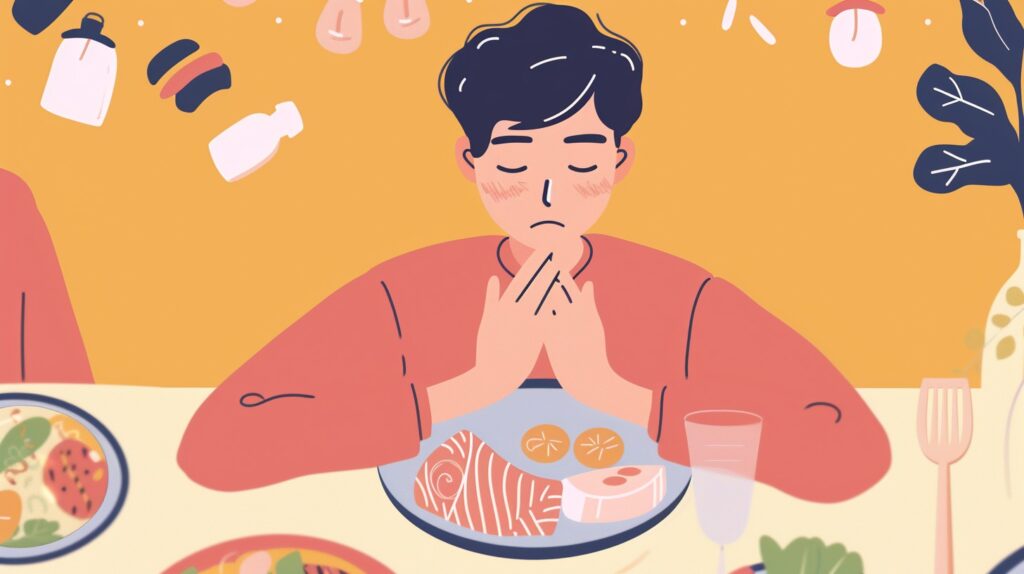
Before we explore further, it’s crucial to recognize that the phenomenon of experiencing anxiety symptoms after eating can stem from both physiological and psychological factors, each contributing uniquely to the condition.
Physiological Factors
My focus here lies primarily on the body’s physical responses. Postprandial, which simply means after eating, shifts in blood flow to facilitate digestion often lead to varied symptoms. For some, these changes manifest as an increase in heart rate and, occasionally, sweating, which one might mistake for anxiety. Furthermore, certain foods act as triggers, stimulating the release of stress hormones and mimicking the sensations of a panic attack. Foods high in sugar and fat can provoke these reactions, leading particularly sensitive individuals to feel irritable or unnerved.
Psychological Factors
When I think about it, I need to remember how the brain works. If before, eating made me feel sick or bad, that could make me expect to get anxious now, which actually makes anxiety happen because I thought it would. Feeling full can be a trigger for me, especially when I link eating with worries about my weight. Also, having mental health issues like generalized anxiety disorder might make me prone to feeling anxious. These feelings of anxiety are not directly related to the food but happen around the same time as eating.
Common Physical Symptoms
I notice that after eating, some body problems often come with feelings of anxiety. Mainly, troubles with digesting food and sugar in the blood can happen and make people feel uncomfortable when they get anxious after meals.
Digestive Discomfort
After I finish eating, clear signs of trouble with my digestion often appear. For example, I could feel sick to my stomach or suffer from poor digestion. These feelings are about discomfort in my stomach and trouble digesting food. Also, when I become anxious, it makes me sweat as the body tries to control its temperature more actively than normal.
- Nausea is a queasiness in the stomach that may come with an urge to vomit.
- Sweating often accompanies the body’s response to stress.
- Indigestion and various digestive disturbances, such as bloating or gas.
Blood Sugar Levels
With regard to fluctuations in blood sugar, I appreciate the complexity of this matter. Indeed, anxiety can precipitate a feeling of shakiness or lightheadedness, symptoms that often correspond with low blood sugar levels. These sensations represent a destabilization of one’s equilibrium, which can lead to further anxiety. Eating may trigger these responses, and they include:
- Shakiness refers to an involuntary motion or trembling sensation, usually of the hands.
- Lightheadedness is a sensation of faintness or near-fainting.
- Low blood sugar is a condition where the glucose levels in the blood drop below normal.
Moreover, individuals might report dizziness, which signifies a sense of spinning or loss of balance, and heart palpitations, characterized by an awareness of heartbeats that feel unusually strong, rapid, or irregular.
Mental Health and Eating Disorders
In exploring the interaction between mental health and eating disorders, I find that anxiety often intertwines with conditions such as anorexia and bulimia, influencing their onset and progression.
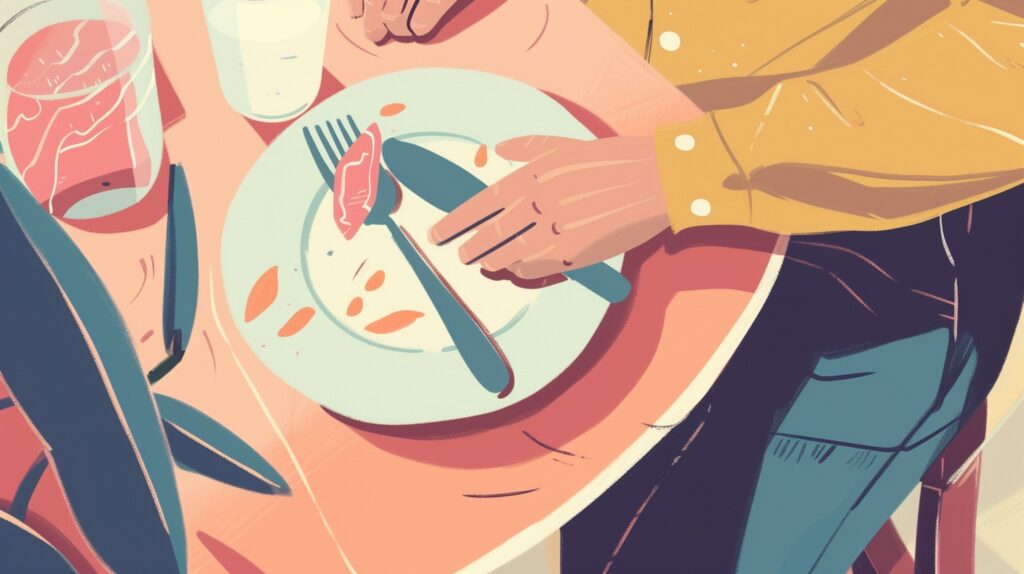
Anxiety’s Role in Eating Disorders
I notice that anxiety acts as both a precursor and a perpetuator of eating disorders. The presence of an anxiety disorder can escalate the risk of developing an eating disorder due to the frequent overlap of symptoms. Studies like those from Sage Journals elucidate this comorbidity, revealing that anxiety may indeed feed into the cycle of eating disorders. Individuals with high levels of anxiety may engage in disordered eating behaviors as a maladaptive coping strategy to lessen their anxiety. This behavior, in turn, may cause guilt and overeating, damaging the mood and exacerbating the cycle.
Anorexia and Bulimia
When I discuss anorexia, I refer to an eating disorder characterized by an intense fear of gaining weight and a distorted body image, leading to restrictive eating and often severe weight loss. Bulimia involves cycles of binge eating and compensatory behaviors like purging. These conditions go beyond mere dietary problems; they severely impact mental health. For instance, the Wiley Online Library provides insights into how women with depressive disorders and anxiety may suffer increased rates of eating disorders. The strain on mental health is evident, as these disorders can create a sense of losing control, impact an individual’s mood, and potentially lead to depression.
I recognize that the psyche’s role in managing these disorders is paramount, necessitating a comprehensive approach that addresses the multifaceted nature of disordered eating and the accompanying psychological distress.
Identifying Triggers
Before examining the specific subsections of Food Sensitivities and Emotional Triggers, it’s imperative to grasp the importance of pinpointing the precise catalysts that provoke anxiety after eating. Recognizing these triggers allows me to anticipate and mitigate potential anxiety episodes.
Food Sensitivities
Foods and Their Effects on the Body:
- Histamine: When I encounter certain foods that release histamine or hinder its breakdown, the immune response can mimic an allergic reaction, fueling anxiety symptoms.
- Insulin Production: When I intake foods high in sugar, my pancreas responds by producing insulin, which sometimes leads to a rapid drop in blood glucose levels, a state known as hypoglycemia, and this can trigger stress responses.
- Common Intolerances: Dairy, gluten, and other common intolerances might not always cause an immediate allergic reaction but they can contribute to anxiety by disrupting normal bodily functions.
Examples include:
| Food Type | Suspected Reaction |
|---|---|
| Aged cheeses | Increased histamine |
| Sugary snacks | Insulin spikes |
| Caffeinated beverages | Stimulates adrenaline production |
Emotional Triggers
How Emotions Relate to Eating
- Associations: Certain foods might evoke powerful memories or emotions. If these are negative, they may lead to feelings of anxiety.
- Alcohol: While many consider it a means to relax, the physiological effects of alcohol can actually heighten anxiety once its sedative effects wear off.
Discovering the intertwining of food and my emotional state necessitates a keen observation of patterns. When I keep a detailed food diary, noting the types of food as well as the timing and context of their consumption, I streamline the identification of potential emotional triggers.
Lifestyle Factors Affecting Anxiety
Awareness of the intricate link between certain lifestyle choices and anxiety empowers me to better manage symptoms. Focusing on diet and the balance between stress and physical activity proves crucial.
Diet and Nutrition
My diet affects my anxiety levels profoundly. High sugar intake may cause fluctuations in blood glucose levels, potentially leading to symptoms of anxiety. Conversely, skipping meals often leads to decreased blood sugar, causing a similar response. I’ve found that maintaining a food diary can help track correlations between my dietary habits and anxious feelings. Limiting caffeine and alcohol consumption is beneficial, as both can exacerbate anxiety. By noting instances of overeating, I also observe its link to anxiety, possibly due to the discomfort and weight gain associated with this habit.
- Avoid: High sugar, caffeine, and alcohol
- Track: Food intake via a diary
- Limit: Overeating to prevent discomfort and weight gain
Stress and Exercise
My personal experience aligns well with studies indicating that engaging in regular exercise contributes to reduced anxiety levels, possibly due to the endorphins released during physical activity. Stress, however, often intensifies my anxiety, but I find that activities like meditation can alleviate this. In instances of food poisoning—an acute, often unexpected stressor—my anxiety levels spike. I’ve learned that both preventing food poisoning through safe food practices and managing stress through meditation are essential for maintaining equilibrium.
- Engage: In regular exercise for endorphin release
- Alleviate: Stress through meditation
- Prevent: Food poisoning to avoid sudden anxiety spikes
Treatment and Management
Dealing with anxiety following eating requires a multifaceted approach, incorporating both professional therapy options and self-help strategies. These approaches aim to manage anxiety symptoms effectively and help individuals regain control over their eating behaviors.
Professional Therapy Options
I recommend varied therapeutic interventions for individuals experiencing anxiety after eating, which may include:
- Cognitive Behavioral Therapy (CBT): This method identifies and changes negative thinking patterns and behaviors.
- Psychiatry: In severe cases, a psychiatrist might prescribe medication to alleviate symptoms.
- Talk Therapy: Engaging in regular sessions with a licensed therapist can uncover underlying causes of anxiety.
Therapy, especially when provided by a mental health professional, equips individuals with coping skills to handle their anxiety. This may include exposure to anxiety-provoking situations related to eating under controlled conditions, which is known to decrease anxiety over time.
Self-Help Strategies
Incorporating simple self-management strategies plays a critical role alongside professional help.
- Relaxation Techniques: Methods such as deep breathing or progressive muscle relaxation can curb acute anxiety symptoms.
- Self-Compassion: Practicing self-kindness helps alleviate the emotional distress associated with eating.
- Coping Skills Development: Understanding one’s triggers and learning effective coping mechanisms reduces feelings of overwhelm during anxious episodes.
Self-help strategies often complement therapy, offering a substantial defense against the challenges associated with social anxiety and eating. Collectively, these approaches foster resilience and provide a tactical means to lessen the impact of anxiety on daily life.
Dietary Considerations
In managing anxiety after eating, I scrutinize my diet closely, focusing on the types of food I consume that may exacerbate or alleviate my symptoms. I’ve noticed how specific foods influence my physical well-being and, thus, my anxiety levels.
Foods to Avoid
I make a conscious effort to limit certain foods that seem to heighten anxiety. First on my list are processed carbohydrates and sugar, as they tend to cause spikes in blood glucose, which can lead to episodes of reactive hypoglycemia—when blood sugar drops suddenly after eating these foods. Next, I avoid trans fats found in several processed foods; trans fats disrupt my energy stability and mood. Similarly, gluten and dairy are on my watch list since they can sometimes provoke digestive issues, leading to discomfort and heightened anxiety. I also reduce my intake of cured meats and products made from white flour since these often contain additives and refined carbohydrates that interfere with stable energy levels.
Foods to Include
Conversely, certain foods benefit me by supporting my mood stability. I opt for fermented foods and those rich in probiotics, like some cheeses and yogurts, as they support gut health, which is intrinsically linked to mental well-being through the gut-brain axis. Including a variety of fruits and vegetables ensures that I’m nourished by essential vitamins and minerals like magnesium, which plays a role in nervous system function. Incorporating healthy fats, particularly from sources like avocados, helps with sustained energy release. By keeping a food diary, I record all dietary changes to document the relationship between what I eat and my anxiety, allowing me to adjust as necessary to maintain a diet conducive to stability and calm.
Mind-Gut Connection
Before I delve into the specifics, it’s essential to grasp that the mind-gut connection represents a complex, bidirectional communication network linking the emotional and cognitive centers of the brain with peripheral intestinal functions.
Gut-Brain Interactions
Gut-brain axis: This term describes the communication network that links your central nervous system, comprising the brain and spinal cord, to your enteric nervous system, which governs gut function. Signals flow incessantly through this axis, affecting both your emotional state and your intestinal well-being. Consider anxiety after eating, which may derive from signals sent from an unsettled stomach to the brain, prompting feelings of unease or distress.
Foods rich in probiotics—fermented ones like yogurt and kimchi—can enhance the diversity and health of the gut microbiota, consequently impacting the gut-brain axis positively. They foster a gut environment that dampens inflammatory responses, sometimes associated with anxiety or depression.
Influence of Microbiota
The microbiota refers to the trillions of microbes living in the digestive tract. Not mere passengers, these organisms play a critical role in processing food and regulating immune responses. An imbalance in these microscopic denizens can spur inflammation, potentially leading to mood fluctuations post-meal.
Probiotic intake can replenish and maintain beneficial bacteria in the gut, aiding in the digestion and absorption of nutrients critical for brain health. By securing the microbiota balance, probiotics may help modulate appetite and emotional responses after eating.
Long-Term Coping Mechanisms
In my pursuit of managing anxiety after eating, I’ve identified two key areas of focus: monitoring my progress and establishing healthy habits. These efforts have played a pivotal role in gradually transforming my eating experiences into more pleasurable ones, devoid of anxiety’s shadow.
Monitoring Progress
I meticulously track my reactions to different foods to identify any potential intolerances that could exacerbate my anxiety. I achieve this by maintaining a detailed food diary, jotting down what I consume and any anxious symptoms that follow. This practice provides me with clear insights into particular foods that may act as triggers.
| Food Item | Date | Symptoms Experienced |
|---|---|---|
| Whole wheat bread | 01/20/2024 | Mild stomach discomfort |
| Chocolate ice cream | 01/22/2024 | No symptoms |
| Coffee | 01/24/2024 | Increased heart rate |
By consistently updating this table, I can discern patterns and make informed decisions about adjusting my diet accordingly.
Developing Healthy Habits
Creating an environment conducive to reducing anxiety involves more than just dietary changes. I focus on integrating distraction techniques into my routine to lessen the focus on any distress while eating. This could involve listening to calming music or engaging in light conversation—activities that demand concentration but also relax.
Additionally, I recognize that certain habits tied to obsessive-compulsive disorder (OCD)—such as an overemphasis on the ritualistic aspects of eating—can hinder progress. To counteract this, I engage in mindfulness exercises that encourage me to remain present during meals and savor each bite. This not only grounds me in the moment but also cultivates an appreciation for the food itself, enhancing the enjoyment of the act of eating.
Frequently Asked Questions
In addressing the common concerns about anxiety following a meal, I will explore the potential causes, the impact of certain foods, symptoms to look out for, digestive influences, management strategies, and the overall relationship between diet and long-term anxiety issues.
What may cause feelings of unease following a meal?
My research points to several factors that might trigger anxiety after eating. These include physiological responses to certain nutrients, imbalances in blood sugar levels, or food sensitivities. For instance, meals high in sugar can cause a rapid spike in blood glucose followed by a quick drop, which may induce feelings of nervousness or discomfort.
How can certain foods influence anxiety levels?
The types of food ingested play a crucial role in influencing anxiety levels. Foods that contain caffeine or high sugar content can exacerbate anxious feelings due to their effects on the body’s hormone levels. This is because caffeine may stimulate the nervous system, and sugar may lead to fluctuations in blood sugar.
Are there common symptoms associated with anxiety after consuming food?
Symptoms of post-meal anxiety might include increased heart rate, sweating, dizziness, or a feeling of unrest. It is vital that individuals monitor and identify their unique reactions to food intake in order to determine patterns that may relate to anxiety symptoms.
Could digestive issues contribute to increased feelings of anxiety post-meal?
Digestive problems, like irritable bowel syndrome (IBS), can indeed influence anxiety after a meal. The gastrointestinal tract is sensitive to emotion; stress and anxiety can exacerbate gastrointestinal symptoms, which in turn may heighten anxiety—it’s a bidirectional relationship.
What strategies can help manage postprandial anxiety symptoms?
To manage post-meal anxiety, I recommend practices such as mindful eating, which involves paying full attention to the experience of eating and drinking, both inside and outside the body. Eating slowly and choosing meals that are balanced in terms of proteins, fats, and carbohydrates may also aid in reducing these symptoms.
Is there a connection between diet and chronic anxiety conditions?
Diet can affect a person’s overall mood and susceptibility to anxiety disorders. Consuming a well-balanced diet rich in vegetables, fruits, lean proteins, and whole grains can help stabilize mood and reduce the incidence of anxiety over time. Conversely, a diet high in processed foods, caffeine, and sugar may increase the likelihood of experiencing anxiety.
